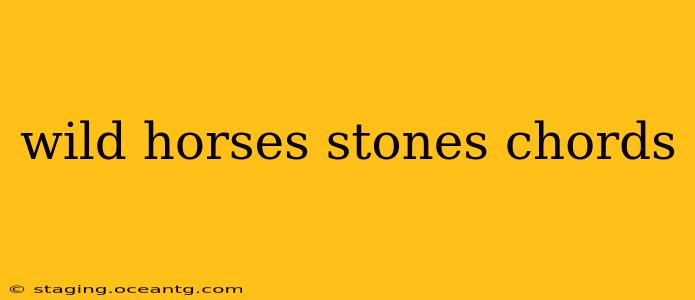The Rolling Stones' "Wild Horses" is a timeless classic, renowned for its melancholic beauty and haunting melody. While there isn't a definitive "Wild Horses Stones chords" chart, as the song's arrangement varies across different live performances and recordings, we can explore the core chord progression and common variations. This guide will delve into the song's harmonic structure, address common questions, and provide insight into understanding and playing this iconic track.
What are the basic chords in Wild Horses?
The core progression of "Wild Horses" revolves around a relatively simple but deeply effective set of chords. The most common and foundational chords are:
- Am (A minor): Often the starting point, creating a melancholic and reflective mood.
- G (G major): Provides a contrasting major chord, adding a touch of sweetness amidst the minor key.
- C (C major): A further contrasting major chord, offering a different harmonic flavor.
- F (F major): This chord completes the progression, leading back nicely to Am.
These four chords form the basis of many versions of the song. However, variations exist, and musicians often add embellishments to enhance the harmonic richness.
What key is Wild Horses in?
The song is primarily in A minor. However, the use of major chords within the progression gives it a subtle complexity that avoids being strictly minor. This creates the song's distinctive emotional ambiguity.
What are the common chord variations in different versions of Wild Horses?
The Rolling Stones themselves have performed and recorded "Wild Horses" in various ways over the years. Different live versions often feature subtle alterations in the chord progression or the addition of passing chords. These changes add depth and nuance to the song's overall sound. For example, you might hear variations that include:
- Dm (D minor): Occasionally used as a substitute or passing chord between Am and G, creating a smoother transition.
- E (E major): Less common, but sometimes employed to create a momentary lift before returning to the main progression.
How are the chords structured within the verses and choruses?
The core Am-G-C-F progression generally forms the backbone of both the verses and the choruses. However, the rhythm and strumming pattern often vary. The verses might employ a simpler, more repetitive pattern, while the choruses might incorporate a more dynamic or embellished rhythm to highlight the lyrical impact.
Are there any fingerpicking patterns for Wild Horses?
Yes, many fingerpicking patterns are possible, and numerous variations exist depending on the player's style and preference. The beauty of "Wild Horses" is that it allows for considerable creativity in the execution. Searching online for "Wild Horses fingerpicking patterns" will reveal numerous options, ranging from simple to complex arrangements.
Can I play Wild Horses on an acoustic guitar?
Absolutely! "Wild Horses" is perfectly suited for an acoustic guitar. Its melancholic beauty shines through brilliantly on an acoustic instrument, showcasing the subtlety of the chord changes and the intimacy of the melody.
Learning "Wild Horses" is a rewarding experience for any guitarist. While there is no single "correct" set of chords, understanding the basic progression and the common variations allows you to approach the song with greater confidence and creativity. Remember to listen to various recordings to hear the different interpretations and adapt your playing accordingly.
